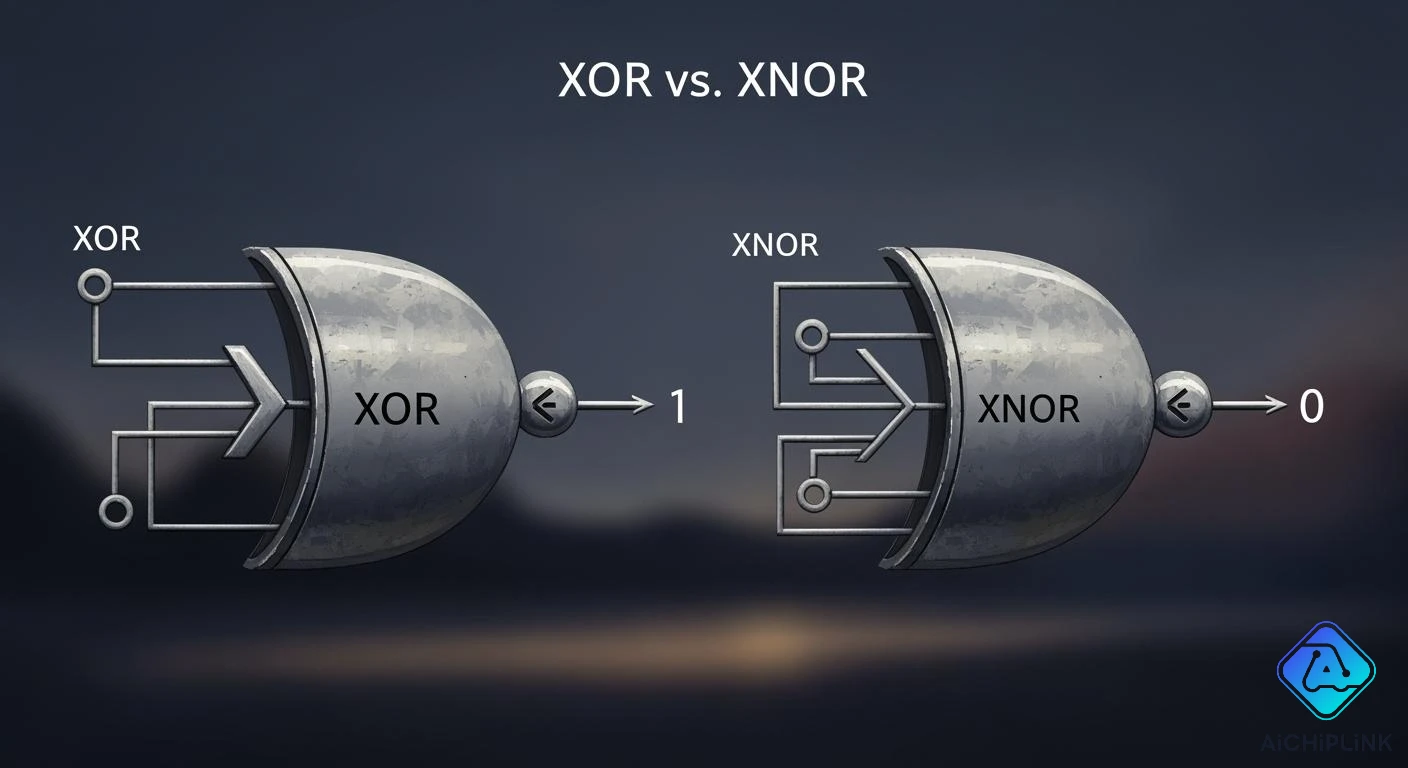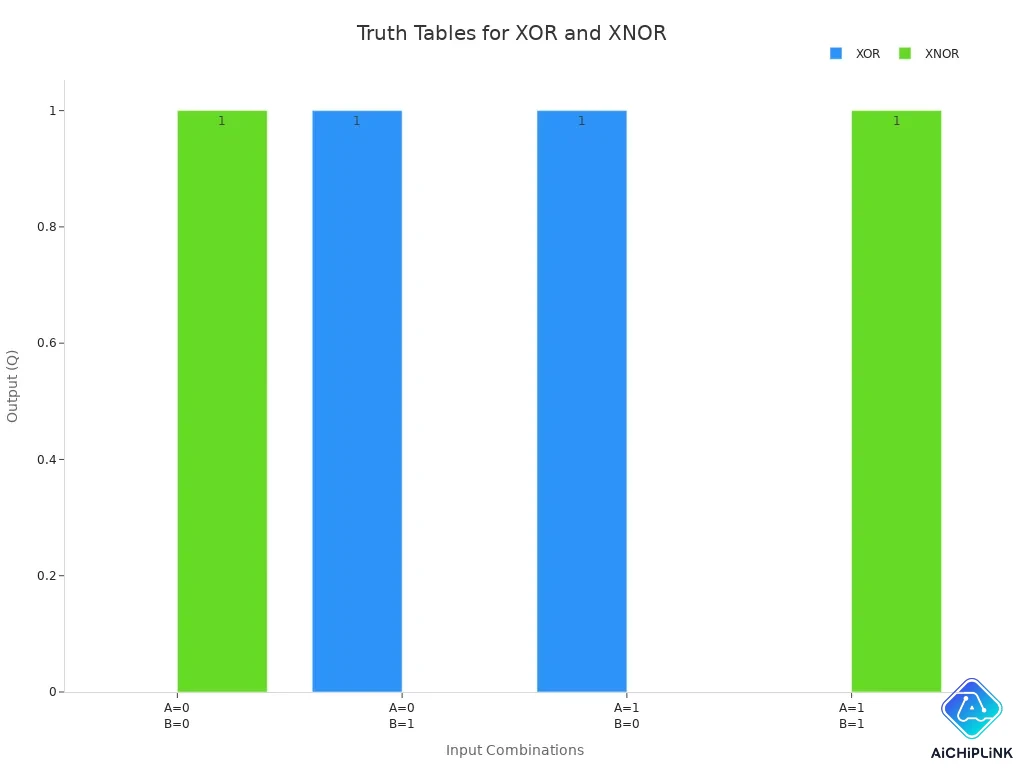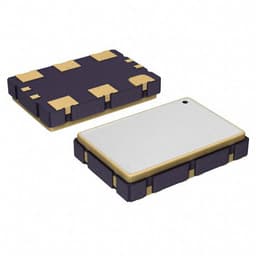
You can see the key difference between XOR and XNOR gates quickly. XOR is like a referee who points out when players have different shirts. XNOR is not the same—it is happy when both players wear the same shirt. You can think of them as tools that find differences or match things. They help make digital choices easy to understand.
Key Takeaways
- XOR gates give 1 when the inputs are not the same, but XNOR gates give 1 when the inputs match. - You use XOR gates for things like adding binary numbers and finding mistakes. You use XNOR gates to check if things are equal and in security systems. - Remember the symbols: XOR does not have a bubble at the end, but XNOR has a bubble to show it does the NOT function.
XOR and XNOR Gates Explained
XOR Gate Basics
You might hear people call the xor gate the "exclusive or gate." This gate checks if two binary inputs are different. If you give it a 0 and a 1, or a 1 and a 0, the output is 1. If both inputs are the same, the output is 0. The xor gate acts like a difference detector. You can see this in the circuit of xor gate, where it lights up only when the inputs do not match. The Boolean equation for the xor gate is T = (A *[B]) + ([A] * B). You will find the xor gate in many digital circuits, especially when you need to spot differences.
XNOR Gate Basics
The xnor gate, also called the exclusive nor gate, works the opposite way. It checks if two binary inputs are the same. If both are 0 or both are 1, the output is 1. If the inputs are different, the output is 0. You can think of the xnor gate as an xor gate with a NOT added at the end. The circuit of xnor gate is useful when you want to know if two things match. The xnor gate is great for equality checking in digital logic.
Logic Symbols & Truth Tables
You can spot the xor gate by its curved shape with an extra line at the input. The xnor gate looks similar but has a small circle at the output. Here is a quick look at the logic symbols:
| Gate Type | Symbol Description |
|---|---|
| XOR | Curved shape (OR gate shape) with an extra curved line at the input side. |
| XNOR | XOR gate symbol with a small circle (NOT bubble) at the output. |
Let’s check the truth table of xor gate and the truth table of xnor gate:
| Gate Type | A | B | Q |
|---|---|---|---|
| XOR | 0 | 0 | 0 |
| XOR | 0 | 1 | 1 |
| XOR | 1 | 0 | 1 |
| XOR | 1 | 1 | 0 |
| XNOR | 0 | 0 | 1 |
| XNOR | 0 | 1 | 0 |
| XNOR | 1 | 0 | 0 |
| XNOR | 1 | 1 | 1 |

Typical Uses of XOR and XNOR
You will see the xor gate in many places. It helps with binary addition, random number generation, and error detection. The xor gate is also used in encryption and as a toggle in digital circuits. Here are some common uses:
-
One-bit adder in binary addition
-
Error detection in data transmission
-
Encryption in digital security
-
Toggle flip-flops for switching states
-
Comparators for checking binary values
The xnor gate is also important. It checks if two binary numbers are equal. You will find the xnor gate in error detection, security systems, and digital calculators. Some uses include:
-
Security alarms and monitoring
-
Low-power arithmetic circuits
-
Memory comparators in computers
The xor and xnor gates help you build smart digital systems. You can use the truth table of xor gate and the truth table of xnor gate to predict how your circuit will behave. Try drawing the circuit of xor gate and the circuit of xnor gate to see how they work in real life.
Key Difference Between XOR and XNOR
Output Comparison
When you look at the key difference between these two gates, it all comes down to their output for each input combination. The xor gate gives you a 1 only when the two binary inputs are different. The xnor gate does the opposite. It gives you a 1 only when the inputs are the same. You can see this clearly in the table below:
| Input A | Input B | XOR Output | XNOR Output |
|---|---|---|---|
| 0 | 0 | 0 | 1 |
| 0 | 1 | 1 | 0 |
| 1 | 0 | 1 | 0 |
| 1 | 1 | 0 | 1 |
If you give both gates the same binary input, the xor gate always outputs 0, while the xnor gate always outputs 1. This is the key difference you need to remember. The xor gate acts like a difference detector. It lights up when the inputs do not match. The xnor gate acts like an equality detector. It lights up when the inputs match.
? Tip: Think of the xor gate as a referee who blows the whistle when players wear different shirts. The xnor gate cheers when both players wear the same shirt.
How to Distinguish XOR vs. XNOR
You might wonder how to tell these gates apart in a circuit or on paper. The key difference is in their function and their symbol. The xor gate has a curved line at the input and no bubble at the output. The xnor gate looks almost the same, but it has a small circle (called a bubble) at the output. This bubble means "not," so the xnor gate is just an xor gate with a not at the end.
Here are some quick ways to spot the difference between xor and xnor gate:
-
The xor gate outputs 1 when the binary inputs are different.
-
The xnor gate outputs 1 when the binary inputs are the same.
-
The xor gate symbol has no bubble at the output.
-
The xnor gate symbol has a bubble at the output.
You will also notice that in some integrated circuits, xor gates may use more power than xnor gates, especially in advanced chips. This can matter if you design circuits that need to save energy.
Quick Reference Table
You can use this table as a quick guide to the key difference between xor and xnor gate. It shows you how each gate works, what it detects, and how to spot it.
| Feature | XOR Gate | XNOR Gate |
|---|---|---|
| Main Function | Difference detector | Equality detector |
| Output is 1 when... | Inputs are different | Inputs are the same |
| Output is 0 when... | Inputs are the same | Inputs are different |
| Symbol | Curved line, no bubble | Curved line, with bubble |
| Typical Use | Binary addition, toggles | Comparators, error check |
| Power Consumption | Can be higher | Often lower |
If you ever get stuck, just ask yourself: "Am I looking for differences or matches?" The xor gate helps you find differences in binary numbers. The xnor gate helps you find matches. This is the key difference you will use again and again in digital logic.
You can use this table to help you tell XOR and XNOR apart:
| Feature | XOR (⊕) – Difference Detector | XNOR (⊙) – Equality Detector |
|---|---|---|
| Function | Looks for differences | Looks for matches |
| Symbol | No bubble at the end | Has a bubble at the end |
? Tip: Draw truth tables or easy circuits. You will notice XOR turns on when things are different, but XNOR turns on when things are the same.

Written by Jack Elliott from AIChipLink.
AIChipLink, one of the fastest-growing global independent electronic components distributors in the world, offers millions of products from thousands of manufacturers, and many of our in-stock parts is available to ship same day.
We mainly source and distribute integrated circuit (IC) products of brands such as Broadcom, Microchip, Texas Instruments, Infineon, NXP, Analog Devices, Qualcomm, Intel, etc., which are widely used in communication & network, telecom, industrial control, new energy and automotive electronics.
Empowered by AI, Linked to the Future. Get started on AIChipLink.com and submit your RFQ online today!
Frequently Asked Questions
What does XOR stand for?
XOR means "exclusive or." You use it to check if two inputs are different. If they are, you get a 1 as the output.
When should you use an XNOR gate?
You use an XNOR gate when you want to know if two inputs match. It gives you a 1 only when both inputs are the same.













